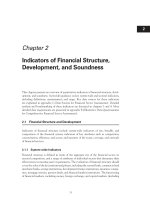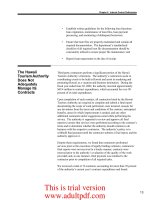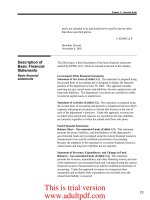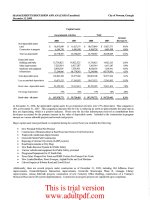Chapter 2: Lack of Planning and Fractured Management Undermine the State’s Tax Collection Efforts_part2 doc
Bạn đang xem bản rút gọn của tài liệu. Xem và tải ngay bản đầy đủ của tài liệu tại đây (465.91 KB, 11 trang )
16
Chapter 2: Lack of Planning and Fractured Management Undermine the State’s Tax Collection Efforts
account for its IT vendor’s hours, which raises questions about whether
taxpayers have received full value for the millions that have been spent
on these contracts.
The tax department also suffered from management conicts and a
dysfunctional work environment that was exacerbated by a derogatory
email from its IT vendor. Those factors led to a six-month delay in the
adoption of potential revenue-generating initiatives and helped spur
a 2009 contract modication that was developed in secret, eliminated
previously required deliverables, and reduced vendor accountability.
We reviewed the department’s IT contracts and found that the
procurement and payment methods of the 1999 ITIM system contract
were transparent. In contrast, the 2008 contract was less transparent
in both its procurement and payment methods. In fact, the contract’s
payment mechanism is questionable.
We found that within the executive branch there is very little guidance
provided to staff to oversee and manage the tax department’s multi-
million dollar IT contracts. Instead, the department relies upon its
in-house expertise, which we found to be lacking. Although DoTAX
management could have relied upon project management provisions in
its various IT contracts, we found that follow-through on these provisions
has been inadequate. In addition, the department has failed to maintain
an accurate accounting of the vendor’s work hours, resulting in weak
vendor accountability.
Lacking statewide and departmental IT project management
guidance, DoTAX leaders relied on inadequate in-house
expertise
The State does not provide project management guidance or oversight
over IT contracts and provides only minimal contract management
training to the executive branch departments. The Information and
Communication Services Division (ICSD) is the lead agency for
information technology in the executive branch. The branch chief of
the ICSD’s Planning and Project Management Ofce stated that her
ofce does not provide IT project management guidance to the executive
departments.
In addition, the State Procurement Ofce (SPO), which provides
authority for procurement rules and procedures for all governmental
bodies in the State, conducts only one workshop on contract
administration and makes available on its website a handout called
DoTAX’s poor IT
project management
enabled weak vendor
accountability
This is trial version
www.adultpdf.com
17
Chapter 2: Lack of Planning and Fractured Management Undermine the State’s Tax Collection Efforts
Contract Administration. The governor’s chief of staff stated that, as a
general rule, the State does not provide guidance and oversight to large
IT projects undertaken by the various executive departments.
Moreover, the DoTAX does not have documented policies, procedures,
guidelines, tools, or methodologies for project management. Key
managers referred to “on-the-job-training” and pointed out that much of
their guidance came from a multitude of department sources, something
they referred to as “fractured documents.”
According to Control Objectives for Information and Related Technology
(CobiT), a generally accepted internal control framework for IT, a
project management framework ensures the correct prioritization and
coordination of all projects, reduces the risk of unexpected costs and
project cancellations and helps ensure the value and quality of project
deliverables. In addition, the Institute of Internal Auditors’ (IIA) Global
Technology Audit Guide 12: Auditing IT Projects (GTAG® 12) lists
several rules for success, including having a formal methodology with
a predened set of process-based techniques that provide a road map
on when, how, and what events should occur in what order; as well
as building and managing the project infrastructure with tools that
enable management of tasks, resources, requirements, change, risks,
vendors, user acceptance, and quality management. Although CobiT
and GTAG® 12 do not guarantee a problem-free project, they emphasize
the importance of having a formal methodology as well as tools and
infrastructure to support project management. We found that the DoTAX
lacks both.
Since 2006, the DoTAX IT project managers have had no project
management or IT background and training. The project manager
responsible for a $2.44 million IT project in 2006 and a $25 million IT
project in 2008 had no prior project management or IT background or
training. The department director, who is the current project manager for
the department’s IT projects, also has neither a project management nor
IT background.
The GTAG® 12’s list of rules for project success encourages
organizations to use project managers who understand the basic skills
and practices, such as certied Project Management Professional from
the Project Management Institute or the like. Similarly, the National
State Auditors Association’s Best Practices Document, Contracting for
Services, states that contract monitoring is essential, one element of
which is to ensure that the contract manager possesses adequate skills
and has the necessary training to properly manage the contract.
Thus, lacking both project management guidance and project managers
with project management experience and IT background, the department
This is trial version
www.adultpdf.com
18
Chapter 2: Lack of Planning and Fractured Management Undermine the State’s Tax Collection Efforts
relied upon project management provisions written into its IT contracts
for guidance. However, even though the contracts contained such
provisions, DoTAX project managers did not follow through with them.
DoTAX’s failure to follow contract provisions led to weak
vendor accountability
We found that project management provisions were included in the
various IT contracts dating back to the original 1999 ITIM system
contract. In fact, the 2008 Delinquent Tax Collection contract and
the subsequent 2009 modication also contained project management
provisions. Although both contracts included such provisions, the
department’s follow through on several of them was inadequate. For
example, a project plan for the 2008 contract was not developed, an
executive steering committee did not provide on-going oversight for both
projects, and monitoring of vendor work hours for the 2009 modication
was inadequate. Exhibit 2.1 summarizes the department’s follow through
with 2008 contract and 2009 modication requirements.
Exhibit 2.1
Summary of Department Follow Through With Contractual Requirements
2008 Contract
Requirement
As Dened by Contract
Adequately
Implemented?
Project Notebook
Sets standards by which the project will be managed and
conducted.
No
Project Plan
Governs the parties’ responsibilities under the contract
and project schedule.
No
Executive Committee
Comprised of senior management from DoTAX and CGI.
Meets semi-monthly or as mutually agreed upon.
No
2009 Modication
Requirement
As Dened by Modication
Adequately
Implemented?
Project Plan
Created within 60 days of contract execution. Addresses
the process for approvals, issue resolution, and project
reporting.
Yes
Executive Committee
Comprised of DoTAX and CGI members including the
department director. Supports delivery of the project.
No
Staff Utilization Plan
Created within 60 days of the contract execution. Sets
the revenue generating activities, the general tasks
that each CGI consultant will perform, and the terms
concerning leave time.
No
Source: Data compiled by Ofce of the Auditor
This is trial version
www.adultpdf.com
19
Chapter 2: Lack of Planning and Fractured Management Undermine the State’s Tax Collection Efforts
According to the 2008 contract, project management would be a
partnership between the DoTAX and the vendor. A project notebook
was specied to establish standards to manage the project. The project
notebook would, at a minimum, address procedures and requirements
for the following: deliverable review and approval; change control;
project plan updates and maintenance; issue tracking and management;
document numbering and storage; meeting minutes; status reporting; and
incident tracking and management. The department did not establish a
project notebook.
The 2008 contract also specied that a project plan would govern the
respective responsibilities under the contract as well as the project
schedule. The vendor’s project manager was responsible for providing
updated versions of the project plan as part of the regular project status
report. The department did not have a project plan; instead, it had
several charts and timelines. The department pointed out that the project
plan is dened in the contract as “the mutually agreed schedule to
implement project activities.” We note, however, that the department’s
charts and timelines do not govern the parties’ respective responsibilities
as required by the contract.
Likewise, the 2009 modication also required a project plan. When we
requested a copy of the plan for the 2009 modication, the department
initially responded that the “Project Plan is dened in Statement of Work
No. 1 as ‘the mutually agreed schedule to implement project activities’”
and provided the schedules. Seven weeks later, the department sent us its
project management plan and explained that the plan details the project
management process that governs the 2009 modication. We question
why the project management plan was not sent to us in our initial request
for a project plan and more importantly, why such a plan was not created
for the 2008 contract.
The 2008 contract also stated that the department and the vendor would
hold executive steering committee meetings semi-monthly or as mutually
agreed upon. The executive steering committee would be comprised of
senior management from both the department and the vendor. Although
the department established such a committee, known as the Oversight
Committee, the committee was discontinued within a year of the signing
of the 2008 contract. The committee maintained an open and closed log
to record its discussions—the last entry was on October 8, 2008.
The 2009 modication also called for an executive committee that
would meet as needed. In addition, the contract stipulates that the
committee would include the department director, its project manager,
and a person of comparable standing from a department outside DoTAX.
The vendor’s members would include its project manager, area account
manager, and one other individual of its choice. According to the
This is trial version
www.adultpdf.com
20
Chapter 2: Lack of Planning and Fractured Management Undermine the State’s Tax Collection Efforts
department, an executive committee was never formed. By disbanding
its Oversight Committee in 2008 and failing to re-establish one after the
2009 modication was signed, the department ignored a clear contractual
requirement, effectively removed a layer of oversight and accountability,
and weakened its project management structure.
According to the National State Auditors Association’s (NSAA)
Best Practices Document, Contracting for Services, once a decision
to contract has been made, the agency should develop performance
requirements that will hold vendors accountable for the delivery of
quality services. The NSAA also warns that without a sound monitoring
process, the contracting agency does not have adequate assurance that
it receives what it contracted for. In the case of DoTAX’s $25 million
contracts in 2008 and 2009, and contrary to the NSAA’s best practice
guidelines, the department inadequately monitored the vendor’s work
hours.
The 2009 modication specied that within 60 days of the execution
of the modication, the vendor and DoTAX would mutually agree on a
staff utilization plan that would identify DoTAX’s revenue-generating
selections as well as the vendor’s other services. The plan would be
updated at least monthly and would contain, at a minimum, the general
tasks that each vendor consultant would be performing monthly for the
ensuing six-month period, as well as reasonable sick and vacation time
allowances. The department developed a staff utilization plan in June
2010 in response to our request, a year after the modication’s effective
date. When asked how the department had accounted for the vendor’s
time prior to June 2010, the department responded that it had not done
so.
We reviewed the staff utilization plan and found that it identied the
individual vendor consultants and listed the percentage of time that
each consultant worked on various initiatives. However, contrary to
contract requirements, the plan did not include the general tasks that
each vendor consultant would be performing monthly for each ensuing
six-month period, nor did it mention leave allowances. The department
did not require the vendor to make up or substitute those hours. In fact,
the department conrmed that these were “lost hours.” Without a more
precise accounting of the vendor’s work, vacation, and sick leave hours,
the department cannot ensure it is receiving maximum value from its
$25 million contract.
This is trial version
www.adultpdf.com
21
Chapter 2: Lack of Planning and Fractured Management Undermine the State’s Tax Collection Efforts
Conicts over how IT work was apportioned to departmental employees
and CGI resulted in a dysfunctional work environment at the department.
These differences grew as the department increasingly relied on CGI
for IT work. Eventually, a derogatory email from a CGI manager to the
former state tax director exacerbated existing rifts within the department
and with CGI. The ensuing halt in services and a disagreement over
contract terms resulted in a 2009 modication that was developed in
secret. That modication departed from the department’s procurement
practice, eliminated previously required deliverables, and reduced vendor
accountability.
Management conicts resulted in a dysfunctional workplace
environment
Many conicts existed among taxation managers resulting from
contrasting personalities, parochial interests, and perceptions that some
tax department managers favored CGI at the expense of department
IT staff. The department’s reliance on CGI for ongoing information
technology support has been a source of internal strife because of
department management’s inability to deal with dissent among its
employees as it became increasingly dependent on CGI to manage and
upgrade the ITIM system.
The governor’s chief of staff stated there was a lot of antagonism
between certain members of the department management team and
CGI, which should have been addressed by leadership. One former tax
department manager described department managers as having strong
personalities and opinions, which resulted in conict in meetings.
Another tax department employee stated, “The divisions and staff ofces
were against each other. The department wasn’t whole.”
Department leaders’ inability to deal with ongoing internal conicts
and properly manage the department’s relationship with CGI resulted
in intervention by the Governor’s Ofce. On two occasions the ofce
removed responsibility for managing the CGI contracts from the former
department director. In both cases that responsibility was shifted to a
deputy director who had no prior project management or IT background
apart from what was acquired while on the job. Following one
intervention by the administration, the deputy director was instructed
to report on project progress to the governor’s chief of staff. These
interventions subverted the department’s management structure and
weakened the relationship between the director and a deputy director
within the department.
In addition, a former tax department manager said there was competition
between the internal IT ofce and CGI for work and that the manner in
Management conicts
contributed to a 2009
contract modication
that was hastily
conceived and vague
and lacked vendor
accountability
This is trial version
www.adultpdf.com
22
Chapter 2: Lack of Planning and Fractured Management Undermine the State’s Tax Collection Efforts
which IT initiatives were directed to CGI resulted in perceptions that
“…how [tax department managers] were using and approving the hours
was troubling…it was an [internal IT ofce] versus CGI to x it…there
were multiple instances where the administration would decide to give
work to CGI rather than [the internal IT ofce].”
Under general terms outlining the department’s relationship with CGI,
tax department practice provided the department’s ITS Ofce with a
so-called “rst right of refusal” in which internal IT staff would be given
the opportunity to decide whether to perform work on new IT projects.
In reality, CGI was given more ITIM system-related business, while
tax department IT staff expressed concern that upgrades that could be
done more cheaply internally were being outsourced. The manner in
which the tax department apportioned work between its staff and vendor
contributed to the growing discord. Some department managers said the
internal IT ofce struggled to deal with new and existing projects. This
drove work to CGI and fueled a perception that some managers favored
CGI. Eventually, strong supporters of CGI and those who were anti-CGI
formed separate factions within the agency.
Disagreements over how work was apportioned between CGI and state
employees also resulted in a complaint led against the department by
the Hawaii Government Employees Association (HGEA), the union
representing many of the department staff. The complaint was lodged on
behalf of department workers who believe civil service jobs were being
wrongly taken by CGI employees.
To resolve these conicts, the tax department needs to attend to practices
and problems that eroded working relationships among employees and
CGI. According to Resolving Conicts at Work, a book by Kenneth
Cloke and Joan Goldsmith, workplace conicts that seem unique or
personal can become widespread as a byproduct of a dysfunctional
environment. This book posits that it costs more money and time to
leave workplace conicts unresolved than to solve them, stating that:
The opportunity costs of leaving these conicts unresolved can
be measured indirectly in the failure of the organization to adapt,
evolve and change. Yet most of these chronic conicts are missed
because the organization sees them as purely personal or a result of
“personality clashes.”
As a result of this dysfunction, the tax department may not meet the
June 30, 2011, deadline to transition away from the IT contractor. “There
is still a trust issue across the board” within the agency, according to one
tax department administrator. The agency’s director stated that some hurt
feelings remain within the department. “Most people have moved on,
but some have not,” he said.
This is trial version
www.adultpdf.com
23
Chapter 2: Lack of Planning and Fractured Management Undermine the State’s Tax Collection Efforts
Derogatory email from IT vendor fueled dissension among
DoTAX managers
Tensions between department ofcials reached a boiling point when a
CGI manager sent a defamatory email on October 8, 2008 to the then-tax
department director. The email described the agency as “operating in a
dysfunctional management environment” and blamed the then-director
for being unable to manage the situation. The email said the then-tax
director “had no management or leadership skills” and recommended
that he be “taken out of the picture” as a manager of the CGI contract.
The email recommended that the then-deputy director be put in charge
of the contract—a move the administration would later implement. The
email, which was derogatory to some but not all managers, was credited
by one deputy director with creating a “terrible, terrible, terrible” work
environment that fostered division.
The former tax director said the email characterized people in a
mean-spirited way, labeling some tax department managers in a
derogatory fashion using inappropriate nicknames. Certain tax
department employees who were deemed “dissidents” were characterized
in disparaging ways, including:
“Clinically psychotic”;•
“Smart yet can be very air headed”;•
“Weak leader and easily manipulated”;•
“EXTREMELY ODD [PERSON]”; and•
“Not respected by his peers within the state.”•
One tax department manager who was not criticized felt isolated and
deemed guilty of cooperating with CGI, while another manager said
statements in the email strained and altered working relationships.
Following the email, some department managers wanted to terminate
the CGI contract; however, it was unclear whether the department could
sever the deal without spurring a lawsuit. The Governor’s Ofce told
the department it could cancel the contract, if it could still bring in the
projected $50 million net revenue within an acceptable amount of time.
CGI also requested a meeting with the Governor’s Ofce to disengage
from the contract.
From October 2008 to March 2009, tax department management
essentially stopped working with CGI. During this period managers
stopped having ITIM system project–related committee meetings and
CGI expressed concerns on the effect this was having on the project.
A CGI executive notied the department that CGI terminated the project
manager responsible for sending the email. The then-deputy director
This is trial version
www.adultpdf.com
24
Chapter 2: Lack of Planning and Fractured Management Undermine the State’s Tax Collection Efforts
managing the project felt that the department would be unable to
generate an added $50 million in net delinquent tax collections without
CGI.
However, even if the department wished to cancel its contract with
CGI, it may not have been able to do so. Prior to the email, there was
a disagreement between CGI and the tax department regarding the
scheduling of payments for Phases 1 and 2 of the contract. Under the
contract, CGI was to receive one-third of delinquent taxes the company
helped generate. However, a separate contract provision limited
payments to the company at $9.8 million until other system upgrades
were complete. The issue was at a standstill with attorneys. The tax
department was advised that litigating the issue “would be expensive.”
This contract dispute and the email drove the decision to modify the
CGI contract in mid-2009. “There were personality disputes, resource
disputes and legal disputes between the department and the contractor.
The amendment helped to resolve these,” said a deputy attorney general
who advised the tax department during the contract modication.
2009 modication was developed in isolation and secrecy
The defamatory email and the resulting ill feelings of management led
to the development of the 2009 modication by a single department
employee—the former deputy director—without the involvement of
the then-director and key managers. According to the former deputy
director, after the email, the majority of the managers and the then-
director wanted to terminate the contract. Instead of seeking their input,
the former deputy director sought assistance from the Department of the
Attorney General and the governor’s chief of staff.
Although the key managers were aware that the contract modication
was being drafted, they did not see the modication until after it was
executed. CGI signed the modication on Tuesday, June 23, 2009. On
Wednesday, June 24, 2009, the former deputy director held a meeting
with the department’s managers. At this meeting, the managers were
provided a summary of the contract modication prepared by the deputy
attorney general. The former deputy director told the managers that the
modication was withheld from them because of the HGEA prohibited
practice complaint.
On Friday, June 26, 2009, the former deputy director asked the internal
IT staff which projects it could perform from the modication summary
and requested their response by the following Monday, June 29, 2009.
The ITS Ofce chief responded on Monday morning via email that “due
to the absence of any input by business units, [the ITS Ofce] would
not be acting responsibly by selecting projects in isolation of needed
input by others. Also, there appears to be no overall business priorities
This is trial version
www.adultpdf.com
25
Chapter 2: Lack of Planning and Fractured Management Undermine the State’s Tax Collection Efforts
established by the department.” Undeterred, the former deputy director
signed the modication that same day—Monday, June 29, 2009.
The chief of staff did not know who was involved in developing
the modication but assumed that the “core team” was working on
it. The deputy attorney general stated that it would surprise him if
the contract modication was drafted by a single person within the
department. He claimed to know rst-hand that there were a number
of managers involved in the negotiation process, but cited attorney-
client privilege when declining to reveal who those managers were or
what was discussed. Moreover, the deputy attorney general stated that
whoever claimed that the modication was drafted by only one person
was misinformed. However, contrary to what she told the department
staff at the time, the former deputy director stated that her decision to
not involve the then-director and managers was inuenced by the email
controversy. She believed that the derogatory nature of the email made it
unlikely that she would receive dispassionate input from the department
ofcials. Thus, developed in isolation and without the assistance of
the director and key managers, the 2009 modication not only failed to
follow the department’s procurement practice, but more signicantly was
ill-planned, hastily conceived, and vague.
2009 modication departed from department’s procurement
practices
We reviewed the 1999 Integrated Tax Information Management (ITIM)
system and the 2008 Delinquent Tax Collection Initiative contracts
and found that both were procured according to the department’s
procurement practices. However, we found that the 2009 modication
did not follow department practices. Contrary to those practices, the
2009 modication did not involve the department administrative services
ofcer (ASO), and management reviews were not documented.
The 1999 ITIM system contract was procured through the request
for proposal (RFP) method. In our review of the contract le, we
noted that the ASO was involved and proper management reviews
and approvals were evidenced throughout the process. As required by
Section 103D-303, HRS, which governs the competitive sealed proposal
method of procurement, public notice was given, three proposals were
received, and the award was made appropriately. The contract also
clearly dened the services to be provided in the Statement of Work 1-12
and contained standard contract language.
The 2008 Delinquent Tax Collection Initiative contract was procured
utilizing the sole source method. Section 103D-306, HRS, which
governs the sole source method of procurement, requires the SPO chief
This is trial version
www.adultpdf.com
26
Chapter 2: Lack of Planning and Fractured Management Undermine the State’s Tax Collection Efforts
procurement ofcer’s approval. We found that the SPO approved the
department’s sole source request based on the information provided by
the department that the contractor developed the software and retains
ownership of the software codes. Similar to the 1999 ITIM system
contract, we found that the ASO was involved, proper management
reviews and approvals were evidenced throughout the process, and the
contract contained clearly dened services.
However, we found that the 2009 contract modication departed from
the department’s procurement practices. In contrast to the 1999 and
2008 contracts, the 2009 modication did not involve the ASO, and
management reviews and approvals were not evidenced throughout the
process. According to the department’s expenditure cycle owchart
on source selection, the ASO is responsible to assist in identifying the
appropriate procurement method. We found that the ASO did not assist
with identifying the procurement method and in fact only became aware
of the type of procurement after the modication was executed and SPO
posted on its website. The former deputy director said that she was
aware that it is part of the ASO’s duties, but she chose not to involve the
ASO.
According to U.S. Government Accountability Ofce (GAO) Standards
for Internal Control in the Federal Government, November 1999,
internal control activities help to ensure that management’s directives
are carried out and are effective and efcient in accomplishing the
department’s control objectives. Control activities are the policies and
procedures, techniques, and mechanisms that enforce management’s
directives. They help ensure that actions are taken to address risks.
The negative environment brought about from the email does not
release the department from following its procurement processes and
procedures. By not including the ASO and the managers in its process,
the department compromised its control activities and failed to comply
with its procurement practices.
2009 modication abandoned 2008 contract deliverables and
vendor accountability
We found that the 2009 modication was driven by the administration’s
need to bring in revenue and did not protect the State’s interest. The
2009 modication released the vendor from 2008 contract deliverables,
removed payment constraints, deleted acceptance testing and warranties
thereby releasing CGI from accountability, and relieved CGI of any
obligation to complete on-going initiatives.
First, the 2008 contract identied 22 initiatives and their deliverables.
The contract denes deliverables as tangible materials that are prepared
This is trial version
www.adultpdf.com









